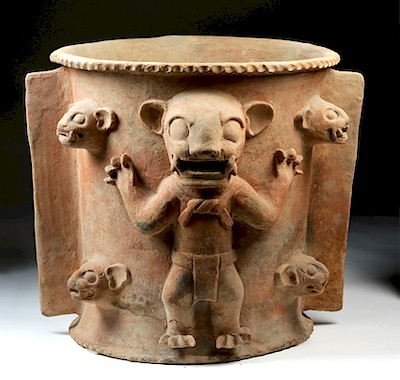Roman Marbled Glass Pouring Bottle - Aubergine & White
Lot 33
About Seller
Artemis Gallery
686 S Taylor Ave, Ste 106
Louisville, CO 80027
United States
Selling antiquities, ancient and ethnographic art online since 1993, Artemis Gallery specializes in Classical Antiquities (Egyptian, Greek, Roman, Near Eastern), Asian, Pre-Columbian, African / Tribal / Oceanographic art. Our extensive inventory includes pottery, stone, metal, wood, glass and textil...Read more
Estimate:
$2,000 - $3,000
Absentee vs Live bid
Two ways to bid:
- Leave a max absentee bid and the platform will bid on your behalf up to your maximum bid during the live auction.
- Bid live during the auction and your bids will be submitted real-time to the auctioneer.
Bid Increments
| Price | Bid Increment |
|---|---|
| $0 | $25 |
| $300 | $50 |
| $1,000 | $100 |
| $2,000 | $250 |
| $5,000 | $500 |
| $10,000 | $1,000 |
| $20,000 | $2,500 |
| $50,000 | $5,000 |
| $100,000 | $10,000 |
| $200,000 | $20,000 |
About Auction
By Artemis Gallery
Dec 6, 2018
Set Reminder
2018-12-06 10:00:00
2018-12-06 10:00:00
America/New_York
Bidsquare
Bidsquare : DAY 2 : Pre-Columbian, Ethnographic & Fine Art
https://www.bidsquare.com/auctions/artemis-gallery/day-2-pre-columbian-ethnographic-fine-art-3699
Day 2 of an important 2-dy auction featuring ancient and ethnographic art from around the world. Today's sale will feature Pre-Columbian, Native American, African / Tribal, Ethnographic, Spanish Colonial, Fine Art, much more. Artemis Gallery info@artemisgallery.com
Day 2 of an important 2-dy auction featuring ancient and ethnographic art from around the world. Today's sale will feature Pre-Columbian, Native American, African / Tribal, Ethnographic, Spanish Colonial, Fine Art, much more. Artemis Gallery info@artemisgallery.com
- Lot Description
Roman, early Imperial Period, ca. 1st century CE. A beautiful mold-formed bottle made from near-opaque, aubergine-colored glass with canes of opaque white glass swirling across the exterior. The bottle is presented with a very slight concave base, a spherical body with a tapering shoulder, a slender cylindrical neck, and a flared rim with a lightly-pinched pouring spout. This type of ancient glass - known as "marbled," "color-band," or "mosaic" glass - is created through a process of casting and blowing which allows the artist to weave strands of different-colored glass throughout the composition. Faint silvery iridescence covers most of the exterior body, and minute pockets of golden iridescence adorn the neck. Stylish vessels like this example would have been used by the ancients to contain scented oils or other precious liquids. Size: 2.8" W x 5.1" H (7.1 cm x 13 cm).
A stylistically-similar example, of a smaller size and with less-elaborate marbling, hammered for $3,250 at Christie's, New York "The Collection of Robert Hatfield Ellsworth Part V - European Decorative Arts, Carpets, Old Master Paintings and Asian Works of Art" auction (March 21, 2015, lot 1245).
Provenance: private East Coast, USA collection
All items legal to buy/sell under U.S. Statute covering cultural patrimony Code 2600, CHAPTER 14, and are guaranteed to be as described or your money back.
A Certificate of Authenticity will accompany all winning bids.
We ship worldwide and handle all shipping in-house for your convenience.
#139596Vessel repaired from multiple pieces with some areas of restoration, overpainting of white marbled detailing, and adhesive residue along break lines. Minor nicks and losses to rim and neck, and some minor abrasions. Scattered areas of faint silver and gold iridescence, and light earthen deposits throughout.Condition
- Shipping Info
-
All shipping is handled in-house for your convenience. Your invoice from Artemis Gallery will include shipping calculation instructions. If in doubt, please inquire BEFORE bidding for estimated shipping costs for individual items.
-
- Buyer's Premium



 EUR
EUR CAD
CAD AUD
AUD GBP
GBP MXN
MXN HKD
HKD CNY
CNY MYR
MYR SEK
SEK SGD
SGD CHF
CHF THB
THB
















